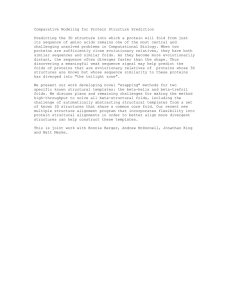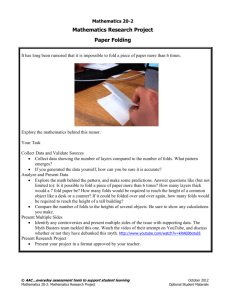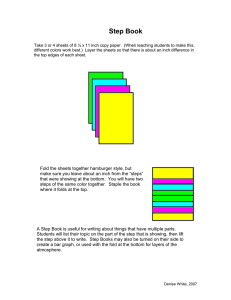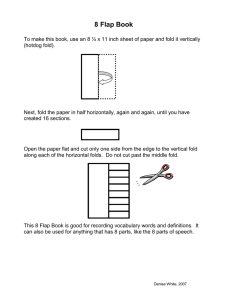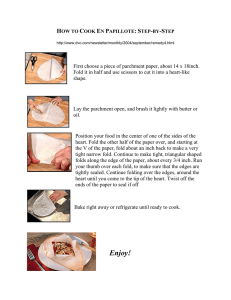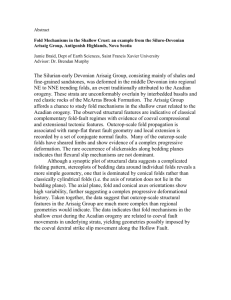Making polygons by simple folds and one straight cut Please share
advertisement
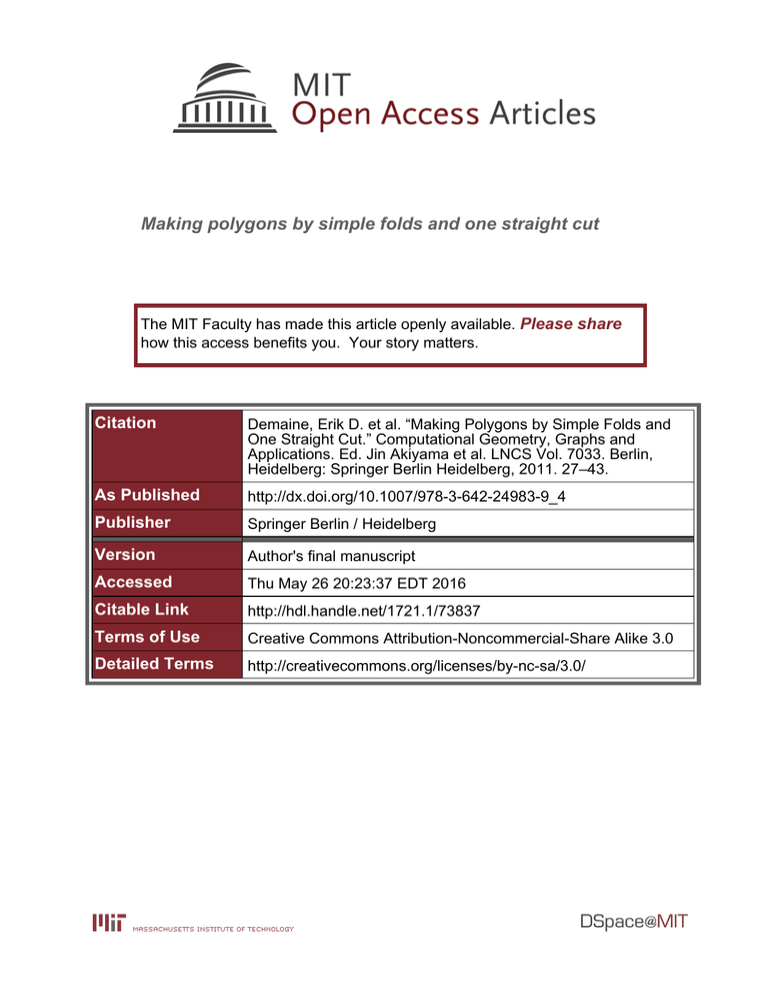
Making polygons by simple folds and one straight cut
The MIT Faculty has made this article openly available. Please share
how this access benefits you. Your story matters.
Citation
Demaine, Erik D. et al. “Making Polygons by Simple Folds and
One Straight Cut.” Computational Geometry, Graphs and
Applications. Ed. Jin Akiyama et al. LNCS Vol. 7033. Berlin,
Heidelberg: Springer Berlin Heidelberg, 2011. 27–43.
As Published
http://dx.doi.org/10.1007/978-3-642-24983-9_4
Publisher
Springer Berlin / Heidelberg
Version
Author's final manuscript
Accessed
Thu May 26 20:23:37 EDT 2016
Citable Link
http://hdl.handle.net/1721.1/73837
Terms of Use
Creative Commons Attribution-Noncommercial-Share Alike 3.0
Detailed Terms
http://creativecommons.org/licenses/by-nc-sa/3.0/
Making Polygons by Simple Folds and One Straight Cut
Erik D. Demaine∗
Martin L. Demaine∗
∗
Po-Ru Loh
Shelly Manber∗
Abstract. We give an efficient algorithmic characterization of simple polygons whose edges can be aligned
onto a common line, with nothing else on that line, by
a sequence of all-layers simple folds. In particular, such
alignments enable the cutting out of the polygon and its
complement with one complete straight cut. We also
show that these makable polygons include all convex
polygons possessing a line of symmetry.
Andrea Hawksley∗
Omari Stephens∗
Hiro Ito†
2 Definitions. The input to the (simple-)fold-and-cut
problem consists of a piece of paper P , which we require to be a polygonal region,1 and a graph G drawn
on P with edges drawn as straight line segments. We
view each vertex v of G as a point of P , and thus each
edge {v, w} of G corresponds to the segment vw, which
we require to be contained in P . In fact, we can also
view G as a subset of P , namely the set of all points on
vertices and edges of G. From this perspective, we naturally remove any degree-2 vertices forming an angle
of 180◦ , as we can simply merge to two incident edges.
For convenience, we refer to such a drawing (G, P ) as
a graffito.2
We make two assumptions about the input graffito
(G, P ). First, we require that P is convex; typically, we
have in mind that P is a square or a rectangle. Second,
we assume that G does not touch the boundary of P ; we
say that (G, P ) has a margin. Both conditions are required only of the initial graffito, as they can easily become violated after making one or more folds; we will
take care to preserve the first property, but the second
property will remain violated after the first fold.
For a graffito (G, P ), we call an all-layers simple fold
feasible if no point of G folds on top of a point in P \ G;
in other words, every point of G folds to either another
point of G or a point outside P . Because we consider
all-layers simple folds, we can effectively glue together
multiple layers of paper into one layer, resulting in a new
polygonal region P 0 of paper, as well as a new graph G0
drawn on P 0 . We write (G, P ) → (G0 , P 0 ) when a feasible all-layers simple fold takes (G, P ) to (G0 , P 0 ). We
write (G, P ) →∗ (G0 , P 0 ) to denote zero or more transitions (G, P ) → · · · → (G0 , P 0 ), allowing in particular
(G, P ) = (G0 , P 0 ).
A graffito (G, P ) is cuttable if there is a straight line
` such that G ⊂ ` (all vertices and edges of G are
on `) and P \ G is disjoint from ` (the rest of the paper is off `). We call a graffito (G, P ) simple-fold-andcuttable if (G, P ) →∗ (G0 , P 0 ) for some cuttable graffito (G0 , P 0 ).
Our model of computation is a real RAM.
1 Introduction. Take a sheet of paper, fold it flat, and
then make one complete straight cut. What shapes can
the unfolded pieces have? This fold-and-cut problem
was introduced formally at JCDCG’98 [3], motivated by
a 1922 magic trick by Harry Houdini, but with history
going back to a 1721 Japanese puzzle book. The answer
is that any pattern of straight-line-segment cuts can be
obtained in this way [3, 2, 4, ch. 17].
We consider a special case of the fold-and-cut problem, called simple fold-and-cut, where we require the
folding process to consist of a sequence of all-layers
simple folds. Given an existing flat folded state, an alllayers simple fold [1]. consists of folding along a line,
through all layers of paper met by the line, by ±180◦ ,
so that afterward all paper is planar and on one side of
the line. We call a graph simple-fold-and-cuttable if a
sequence of all-layers simple folds brings the graph’s
vertices and edges to a line, with no excess paper on
that line.
We prove the two main theorems.
Theorem 1 There is a strongly polynomial-time algorithm for determining whether a given (not necessarily convex) simple polygon is simple-fold-and-cuttable,
starting from a convex piece a paper strictly containing
the polygon.
The polynomial running time is
a function of the number n of vertices in the input polygon, even
though the number of required simple folds can be arbitrary large for
a fixed n; see Fig. 1. As a result,
when a polygon is simple-foldand-cuttable, the algorithm produces only an implicit representation of the folding sequence. An
explicit representation can be obtained, at the cost of adding to the
running time a term linear in the
output size.
Figure 1: As the
3 Algorithm. How do we determine simple-fold-andcuttability of a graffito (G, P ) where G is a simple polygon, and P is convex and has a margin around G? The
first step is to find G’s lines of reflectional symmetry, because the first feasible fold must be such a line: a simple
fold reflects one side onto the other, and cannot map G
to anything other than G because of the margin. All such
two acute base symmetry lines can be found in O(n) time, where n is
Theorem 2 A convex polygon is angles
approach the number of vertices in the polygon [5]. In particular,
simple-fold-and-cuttable if and π/2, the number of
there are at most O(n) lines of symmetry. Our algoonly if it has a line of reflectional simple folds grows
rithm tries each of these lines as the first fold, and for
without bound.
symmetry.
each spends O(n2 ) time testing whether the remainder
is simple-fold-and-cuttable, for a total time of O(n3 ).
∗ MIT Computer Science and Artificial Intelligence Lab-
oratory, 32 Vassar St., Cambridge, MA 02139, USA,
{edemaine,mdemaine,hawksley,ploh}@mit.edu,
shellym@alum.mit.edu, xsdg@xsdg.org
† School of Informatics, Kyoto University, Kyoto 606-8501, Japan,
itohiro@i.kyoto-u.ac.jp
1 We treat a piece of paper as a closed region, namely, the set of all
points interior or on the boundary of the polygon.
2 “Graffito” is the singular form of “graffiti” (both in English and
Italian), though it seems rarely used in English.
1
Suppose the first fold is (G, P ) → (G0 , P 0 ). Then
(G0 , P 0 ) is a passage, meaning that it is a graffito satisfying the following three conditions:
G is a simple polygonal line, the two endpoints of G are on the
boundary of P , and no point of G except the two
endpoints is on the boundary of P .
The last property follows from our assumption that P has a margin
around G.
It remains to characterize simple-fold-and-cuttable
passages in O(n2 ) time. Our algorithm follows a greedy
approach, repeatedly making feasible folds, until either
getting stuck or the result is cuttable. This idea is motivated by the following lemma, which states that feasible
folds can never hurt.
3.2 Finding feasible folds that hit a non-end vertex/edge.. For each non-end vertex and the midpoint
of each non-end edge, we test foldability of the angular bisector (perpendicular for midpoints) in O(n) time
by walking in both directions from the starting point,
testing for symmetry locally around each pair of vertices visited (taking into consideration local neighborhoods of boundary points), until passing an endpoint in
either direction, after which feasibility is guaranteed by
the convexity of P . The total time is O(n2 ).
3.3 Computing the limit of folds that cross just end
edges.. We distinguish two cases according to whether
the two rays extending the end edges beyond G’s endpoints intersect.
First consider the case in which the rays do not intersect. For each end edge e = v0 v1 with end vertex
v0 , we project the union of the non-end edges (which
form a path starting at v1 ) onto the line through e, obtaining in O(n) time a line segment s containing v1 .
No fold through e that crosses only end edges can pass
through s; thus, if s contains e, then no fold across e
is possible. Otherwise, the endpoint of s closer to v0
is a strict upper bound on the extent to which e can be
folded.
If the above procedure provides information that
some or all of an end edge e0 cannot be folded, then
we project the nonfoldable segment of e0 onto the opposite end edge e and update the bound for e accordingly.
(If we have nonfoldability information about both end
edges, then we apply the above step twice, using each
edge to update the other.) We show that the updated
bounds are the desired limits, that is, the end edges can
be folded to within infinitesimal amounts of their updated bounds, and in particular, updating the bound for
e can give us no new bound on the foldability of e0 .
The situation is slightly different if the rays extending
the end edges do intersect at a point X: in this case, it
is possible that the above approach would cause an infinite cascade of back-and-forth bound updates on the
two end edges. Fortunately, in this case, the end edge
farther from X is actually not foldable at all, so it suffices to apply the projection method once to determine
the foldability of the end edge closer to X.
Lemma 1 If (G, P ) is a passage, P is convex and has a
margin around G, and (G, P ) → (G0 , P 0 ), then (G, P )
is simple-fold-and-cuttable if and only if (G0 , P 0 ) is
simple-fold-and-cuttable.
Proof sketch: Because of the passage property, one side
of the fold has a shorter part of G, and because of the
margin property, this part folds on top of the larger part
and effectively disappears; thus G0 ⊂ G. (This is the
critical point where we use that the original graph is a
polygon.) But we may not have P 0 ⊂ P . To fix this,
we fold P 0 down to a convex subset of P ∩ P 0 . Now
any simple-fold sequence for (G, P ) applies as well to
(G0 , P 0 ).
2
A high-level description of our passage algorithm is
as follows. Initially we mark the endpoints of G as
“real”; in the future, the endpoints may become marked
as “limit” (meaning that the end edges are in fact slightly
longer, but can be shortened arbitrarily close to reaching
this endpoint). Throughout, we maintain the invariant
that (G, P ) is a passage. The algorithm repeatedly loops
through the following steps. First, we replace P with
the convex hull of G, with the understanding that every
boundary point of this hull should in fact be surrounded
by a small (infinitesimal) neighborhood of paper, except
for the real endpoints of G which are truly on the paper boundary. (At limit endpoints, the end edges of G
extend in the same direction infinitesimally beyond the
limit endpoints, to reach the boundary of P .) Now we
look for feasible folds that either hit a vertex of G other
than an endpoint, or cross an edge of G other than an
end edge. If there is at least one such fold, we arbitrarily chose one and fold it, marking the new endpoint as
real. If there are no such folds but there are feasible folds
through end edges, we compute the limit of repeatedly
folding folds that cross just the end edges (as detailed
below), and mark any modified endpoints as limits. If
there are no feasible folds whatsoever, then (G, P ) is
simple-fold-and-cuttable if and only if it is cuttable, i.e.,
a single edge. In the former two cases, we proceed to
the next iteration of the loop, trimming to the convex
hull and searching for the next suitable fold.
This description leaves out a few algorithmic details:
4 Convex Polygons. Proof sketch of Theorem 2:
The “only if” part is trivial. After the first simple fold,
we are left with a passage (G, P ) where G is a convex
polygonal line. At least one of the end edges of G can
be made arbitrarily small by folding through it. Once
an end edge is smaller than its adjacent edge, we can
fold the end edge onto its adjacent edge, reducing the
number of edges. Repeat.
2
References.
[1] E. M. Arkin, M. A. Bender, E. D. Demaine, M. L. Demaine,
J. S. B. Mitchell, S. Sethia, and S. S. Skiena. When can you
fold a map? Computational Geometry: Theory and Applications,
29(1):23–46, 2004.
[2] M. Bern, E. Demaine, D. Eppstein, and B. Hayes. A disk-packing
algorithm for an origami magic trick. In Origami3 : Proceedings
of the 3rd International Meeting of Origami Science, Math, and
Education, pp. 17–28, 2001. Also FUN 1998.
[3] E. D. Demaine, M. L. Demaine, and A. Lubiw. Folding and cutting paper. In Revised Papers from the Japan Conference on Discrete and Computational Geometry, pp. 104–117, 1998.
[4] E. D. Demaine and J. O’Rourke. Geometric Folding Algorithms:
Linkages, Origami, Polyhedra. Cambridge Univ. Press, 2007.
[5] J. D. Wolter, T. C. Woo, and R. A. Volz. Optimal algorithms
for symmetry detection in two and three dimensions. The Visual
Computer, 1(1):37–48, 1985.
3.1 Computing the convex hull.. We can compute
the convex hull of the polygonal line G in linear time
using, e.g., Melkman’s algorithm. The intuition behind
replacing P with the convex hull of G (plus an infinitesimal “fringe”) is that we can always fold P down to be
arbitrarily close to this hull without touching G, and this
may create new feasible folds.
2

